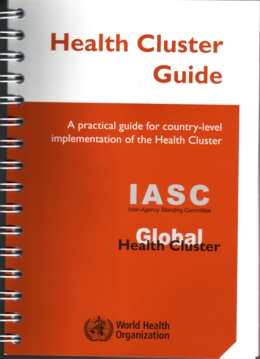 This Guide suggests how the Health Cluster lead agency, coordinator and partners can work together during a humanitarian crisis to achieve teh aims of reducing avoidable mortality, morbidity and disability, and restoring the deliveryof and equitable access to preventive and curative health care as quickly as possible.
It highlights key principles of humanitarian health action and how coordination and joint efforts among health sector actors working in partnership can increase the effectiveness and efficiency of health interventions. It draws on IASC and other documents but also includes lessons from field experience.
Chapter 1 explains the role of a helath cluster at national and, where needed, sub-national levels, and suggests the principal actions that need to be taken during different phases of response. A table in section 1.2 summarizes the main roles and functions of the health cluster coordinator (HCC), the country cluster lead agency (CLA), and cluster partners.
Chapter 2 outlines what needs to be done to establish and sustain an effective cluster while chapters 3 to 8 provide guidance in relation to the specific function listed in section 1.2. Each chapter highlights the key principles, summarizes what needs to be done and considered, lists the tools and guidelines that are available, indicates the challenges likely to be faced, and provides practical hints and references for further guidance. The tools and guidelines referred to include, but are not limited to, those developed by the Global Health Cluster.
The annexes and additional documents on the accompanying CD-ROM provide essential complementary information.
Contents:
Acknowledgements
Contents
Goal and Expected Outputs
About this Guide
Acronyms and abbreviations
Glossary of key terms (and concepts)
1. Role and Functioning of a Health Cluster
1.1 The ”Cluster Approach“
1.2 Role of a health cluster
1.3 Roles of the cluster lead agency, coordinator and partners
1.4 Cluster activities during different phases of health response
2. Assuring Effective Coordination
2.1 Engaging partners; building an effective health cluster
2.2 Mapping health actors
2.3 Holding successfull cluster meetings
2.4 Working with other clusters and coordinating entities
2.5 Assuring good information management
2.6 Disseminating information – managing external communications
3. Assessing and Monitoring the Health Situation
3.1 Key health information needs, processes and tools
3.2 Mapping health resources & services – using HeRAMS
3.3 Organizing an initial rapid assessment (IRA)
3.4 Organizing follow-up assessments and surveys
3.5 Assuring early warning and response: establishing an EWARS
3.6 Monitoring the health situation; re-establishing a regular HIS
3.7 Monitoring the performance of health services
4. Analysing and Prioritizing
4.1 Identifying and analysing problems, risks and gaps
4.2 Prioritizing problems and response actions
5. Developing a Strategy; Planning
5.1 Developing a health sector response strategy
5.2 Preparing the health component of a Common Humanitarian Action Plan
5.3 Supporting health system recovery
5.4 Taking account of cross-cutting concerns
5.5 Developing (in-crisis) contingency plans
6. Ensuring Standards
6.1 Ensuring standards; promoting best practices
6.2 Defining and meeting training needs; building capacity
7. Advocacy and Resource Mobilization
7.1 Preparing health inputs to a ”flash“ appeal
7.2 Proposing CERF applications for the health sector
7.3 Preparing, monitoring and reviewing a consolidated appeal
7.4 Working with donors, accesing funds from other sources
8. Monitoring Cluster Performance; Learning Lessons
8.1 Monitoring implementation of health cluster response
8.2 Organizing evaluations and ”Lessons-learned“ exercises
9. Standard Services and Indicator Lists
9.1 Levels of health care, sub-sectors and services
9.2 Indicators and benchmarks
Post Date : 04 Mei 2010
|
